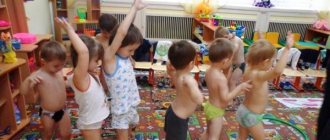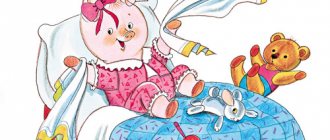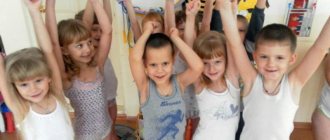MAGAZINE Preschooler.RF
Synopsis of a swimming lesson. Senior group. Theme: "Goldfish"Physical education instructor at MADOU kindergarten No. 10 Vitkalova I.S. Kanevskaya, Krasnodar region.
Goal: promoting a healthy lifestyle, developing creative abilities in children.
Software tasks:
- consolidate swimming skills and abilities: crawl legwork when swimming on the front and back, with a swimming board; elements of breaststroke swimming technique; coordination of movements when swimming in a non-sports manner
- develop coordination of movements when performing exercises in water
- consolidate elements of water aerobics, hydroplastics and synchronized swimming in musical compositions; develop the ability to perform exercises synchronously
- develop agility, speed and overall endurance
- train the breathing muscles
- help prevent flat feet and poor posture
- cultivate courage; kindness, responsiveness to someone else's misfortune; give every child the opportunity to feel like they belong to a close-knit group of like-minded people; improve children's environmental culture
- bring joy to children and create a good mood.
Materials for the lesson: stereo system, CD with soundtrack
V. Shainsky to the song “Chunga-Changa” , music by M. Dunaevsky to the song “Vodyany” from the cartoon “The Flying Ship” , music of Andrei Petrov’s waltz from the film “Beware of the Car” ; costumes of postman Pechkin, Vodyanoy, rubber toys (frog, duck, heron); an envelope with a letter from Neptune, a mini aquarium with a swimming fish; swimming boards, small inflatable balls (8 pcs), sinking toys (crayfish - 5 pcs), two baskets with floating objects (tennis balls, disposable plastic dishes, small rubber balls - “jumpers” , plastic cubes, etc.).
Progress of the lesson.
Instructor:
Good morning, have a wonderful day! We gathered as if for a holiday. Isn't it nice for the kids to play with me in the water?
Children: Yes!
There's a knock on the door.
Instructor:
Hush, kids, what kind of knock suddenly came on our door? Who is rushing towards us so carelessly?
The postman enters - Pechkin.
Hello, yes this is Pechkin!
Pechkin: I have a letter for you -
Get it!
He hands over the letter and leaves.
Instructor:
The postman was in a hurry for good reason - he brought the news from the king of the sea. He wouldn’t bother us just like that, Something terrible happened, maybe?
Opens and reads the letter. “I, Neptune, the Lord of the sea, strike you with my brow and mourn: the merman, the scoundrel, stole
My goldfish. But fresh water is so harmful for the baby! Help out, help!
Save the fish quickly. The river inhabitants will help you find the right path!”
INSTRUCTOR: Shall we help the Lord of the Sea?
Children: Yes!
Instructor:
Then - good luck! We start with the pond! Get into the water quickly and find your places.
We imitate movements, Imitating, in exercises.
At the instructor's signal, the children perform the exercises.
1. Imitating a boat with oars, Leaning towards the water, We walk and row our hands through the water. Game exercise “Boats with oars” : walking along the bottom, helping with rowing movements of the hands.
2. Walk like ducks in a half-squat in the water. Dive more often, blow more bubbles.
Game exercise “Ducks and dives” : walking along the bottom in a half-squat, alternating inhalation and exhalation into the water, plunging headlong under the water.
3. Imitating frogs, Jump - splash, jump - splash, Jump cheerfully, my friend!
Game exercise “Frogs are funny” : from a crouching position, jump forward on two legs and squat again.
A toy appears in the hands of the instructor - L yushka. He imitates the voice of a frog.
Frog:
Hello, croak - croak, friends! I will show you the way, Which will lead to Vodyanoy. But first we’ll gain strength -
Let's all exercise together.
Children line up first - second and line up in two lines
Take the balls in order, Look, listen, understand
And repeat after the frog!
The music of V Shainsky sounds on the song “Chunga - changa” . Children perform a hydroaerobics complex with a ball “Exercising the Frogs” .
1. “The little frogs woke up and stretched”.
IP: standing, arms with the ball extended forward. Raise your arms straight up, stretch on your toes (4 times).
I.p.: standing, hands with the ball behind the head. Straighten your arms up, stretch on your toes (4 times).
2. “The little frogs are squatting, stretching their legs”.
I.p.: standing, hands with the ball behind the head. Straighten your arms forward, squat, spreading your knees and feet to the sides (4 times).
I.p.: standing, hands with the ball in front of the chest. Straighten your arms forward, squat (4 times).
3. "The frogs turn and look around"
I.p.: standing, hands with the ball behind the head. Turn the body right - left (4 times in each direction).
I. p.: standing, hands with the ball in front of the chest. Turn the body to the right - left with straightening the arms in the direction of the turn (4 times in each direction).
4. “The little frogs are squatting again, stretching their legs”.
I.p.: standing, hands with the ball in front of the chest. Straighten your arms forward, squat, spreading your knees and feet to the sides (4 times).
5. “The little frogs bend over and are called tumblers.”.
I.p.: standing, arms with the ball extended upward. Tilt the body to the right - left (4 times in each direction).
I.p.: standing, hands with the ball behind the head. Tilt the body to the right - left (4 times in each direction).
6. “The baby frogs lean forward as if they are worshiping a heron.”.
I.p.: standing, hands with the ball behind the head. Bend your torso forward, lower your face into the water (4 times).
I.p.: standing, hands with the ball behind the head. Straighten your arms forward, tilt your torso forward, lower your face into the water (4 times).
7. “The frogs blow bubbles and pretend to be a pump.”
I.p.: standing, arms with the ball extended upward. Squats with exhalation into the water (4 times).
I.p.: standing, hands with the ball behind the head. Squats with exhalation into the water (4 times).
8. “The little frogs are having fun, jumping, spinning”.
I.p.: standing, hands with the ball in front of the chest. Jump on the right leg, then on the left leg (4 times each).
I.p. standing, hands with the ball in front of the chest. Jumping on two legs 4 times with a turn to the right (360 degrees).
8. "The little frogs are resting and playing with a ball".
I.p.: hands with the ball in front of the chest. Walking in place while restoring breathing.
IP: walking in place, arms extended to the sides, ball in one hand - inhale. While walking in place, raise your arms straight up, transfer the ball to the other hand - exhale.
Children line up in one line and pass the balls.
Frog:
Well done, brothers! Should we swim breaststroke? The frog style is eternal - We won’t swim to the river with it!
1 task:
With breaststroke on your chest, swim to the side. Bend your legs, straighten them, and glide through the water.
Exercise: sliding on the chest with breaststroke footwork, holding the breath.
Task 2:
Hands breaststroke on your chest Glide through the water. Hands bent to the sides, brought forward together,
Together we swim to the signal.
Exercise: sliding on the chest with breaststroke, holding the breath.
Task 3:
Coordinate movements We learned during classes in the water. Hands - breaststroke, legs - crawl, Swimming is convenient for children.
Exercise: sliding on the chest with coordination of movements of the arms in breaststroke and legs in freestyle, holding the breath.
Frog: We got to the river together.
To you, kids,
It's time to look for other helpers.
Farewell!
A toy appears in the instructor’s hand - a tak.
Duck:
Quack, quack, quack, guys! How do you swim okay! The frog whispered to me: “You really need to see Vodyanoy?”
And the clue is carried by a river crayfish at the bottom. You can catch him quickly - Duck - dive!
Sinking toys (crayfish) are lowered to the bottom in advance. There is a note attached to one of the crayfish - a hint.
Duck-dive game .
Children dive headfirst, trying to find crayfish at the bottom of the pool. At the same time, both legs bent at the knees are raised - “showing the tail .
One of the children takes out a crayfish from the bottom, to which a note with a hint is attached.
INSTRUCTOR: (Unfolds the note and reads it loudly)
“You need to swim on your chest and on your back with a board in your hands. Move rhythmically and quickly with your legs and crawl together.”
Exercise: swimming on the front and on the back with a board: the legs work like a crawl in coordination with breathing.
A toy appears in the hands of the instructor - a claw. He imitates the voice of an old heron.
T a p l i:
I've been living in a swamp for a long time! Nobody just walks around here. Did you come for the golden fish? Barely alive, exhausted,
She can hardly breathe without sea air.
Are you ready to help?
Children: Yes.
T a p l i:
You breathe like a “pump” Game exercise “Pump” . Standing in a line with their backs to the side, at a signal, children exhale repeatedly into the water.
the “Vodyanoy Song” from the cartoon “The Flying Ship” plays .
Water appears.
Water:
I am the Lord of the swamps, and accordingly I will become. But why do I want to fly - No one cares about that.
That’s why I’m angry and harmful and completely unscrupulous. So I’ll take it and eat a goldfish for lunch!
Instructor:
What are you, what are you, Vodyanoy! Are you that bad? Remember how Ivan the Wonderful helped build a ship!
You didn't get enough sleep, guess? Wait a minute to eat the fish! Let's figure out what's going on here. What are you tired of here?
Water:
Look what's going on - They've muddied up all the water: Flasks, jars, rags, krinkas, Even torn shoes!
Who wants to get into such rubbish for the whole day? There is no one left here, even the fish have fled.
Instructor:
Stop - why are you scolding - We will clean up all the water! We'll collect the garbage in no time - the swamp will become a lake!
Game "Collect garbage" .
The pool water area is divided in half by a dividing path. Accordingly, the children are divided into two teams and lined up along one of the sides. of “garbage” (disposable plastic tableware, tennis balls, cubes and other floating objects) is randomly scattered from the baskets onto the water area of each team At the signal, the children of both teams quickly collect “garbage” into their baskets standing on the opposite side. The team that collects “its trash” first wins.
Water:
Respected, thank you, Vodyanoy. Are you ready for other tests? I’ll give you the fish, so be it, But you’ll have to swim through the tunnel!
Game exercise “Swim through the tunnel” . Four children form a tunnel from two hoops. The rest of the children line up in a column one at a time. At a signal, children take turns performing a front slide with crawl footwork through a tunnel of vertically held
hoops, trying not to touch the hoop.
Water:
Oh yes, children, that’s how they are masters! The water in the lake has become clean! The fish are coming back - it’s nice for them to frolic in the clean!
Should I introduce you to the fish?
Children: Yes!
Water: Can you name which ones without difficulty?
Children call fish.
Instructor:
The fish are dancing in the pond - their tails are twisting and twisting! How our children dance. Do you want to take a look at Vodyany?
Accept a gift from them -
Dance of the goldfish!
A waltz sounds to the music of A. Petrov from the movie “Beware of the Car” . Children perform dance movements with elements of synchronized swimming, hydroplasty (wave-like movements of the arms from right to left, from top to bottom, tilting the body back, squats; “float” with a “star” ; formation in a circle facing each other, holding hands at the top, backs to each other with arms around the waist, bending the body back and forth facing into the water, walking at an extended step with a half-squat in one direction and the other; “ float” - “arrow” ; turning around in a circle facing each other; performing wave-like movements arms with the torso tilted back and squatting).
Water:
How light and clear my soul is! I haven't rested for a long time. I’m very glad to make friends with you, I saw sympathetic guys,
Clever, brave, generous and attentive, and so talented in the water! Here's a fish for you, and go with God. Well, I'll go take a little nap.
The merman gives the instructor a mini-aquarium with a swimming fish, says goodbye to the children and leaves.
Children come up to the side and look at “golden” fish.
Instructor:
Children, acting deftly and boldly, you did a good deed: you returned the goldfish to Neptune, you helped the Vodyanoy a little.
The tests passed all marvelously, thank you very much for that! It's time for us to say goodbye, See you again in the water, friends!
The lesson is over. One by one, the children climb the stairs out of the water.
Literature.
- Osokina T.I., Timofeeva E.A., Bogina T.L. Swimming lessons in kindergarten. M., 1991.
- Pishchikova N.G. Swimming training for preschool children. M., 2008.
- V.S. Vasiliev. Teaching children to swim. M., 1989.
- S.V. Yablonskaya, S.A. Cyclis. Physical education and swimming in kindergarten. M., 2008.
- M.D. Makhaneva, G.V. Baranova. Figure swimming in kindergarten. M., 2009.
| Next > |
DRY SWIMMING PLANS FOR PRESCHOOL CHILDREN
Objectives: Learning to inhale and exhale through the mouth. Teaching the “float” and “jellyfish” exercises. Inhale quickly through the mouth, exhale through the mouth and lips with a “tube” for a long time. IP - bend your arms forward, raise your head - inhale, lower - exhale. I.p. – o.s., sit down, group, hold your breath, stand up – exhale. I.p. – o.s., take the “float” position, stand in the “star” position, chin down.Objectives: Learning to imitate body position in water. Training in imitation of footwork with crawl on the back and chest. I.p. - stand with your arms up, stretch (slide). IP - bend your arms forward, raise your head - inhale, lower - exhale. I.p. – “arrow”, imitation of crawl footwork. IP - sitting legs forward, alternating movements of legs up and down. I.p. - lying on the chest (sliding), crawl leg work. The same on the back.
Objectives: Learning how to work a dolphin's legs. I.p. - stand with your arms up, stretch (slide). IP - bend your arms forward, raise your head - inhale, lower - exhale. IP - sitting legs forward, simultaneous movements of legs up and down. I.p. - o.s., movements of the pelvis forward - arms back, movements of the pelvis back - arms forward. I.p. - stand with your arms up, springy tilts of the body forward and back. I.p. – stand, arms up, wave-like imitation movements of the body like a dolphin.
Objectives: Learning breaststroke legwork. I.p. - stand with your arms up, stretch (slide). IP - bend your arms forward, raise your head - inhale, lower - exhale. I.p. - bending the hands to the knees, circular movements of the knees in different directions. I.p. - breaststroke, hands at the top, stretch your arms up. I.p - o.s., walking on heels, toes out. The same thing, jumping on two legs. I.p. - lying on the chest (sliding), breaststroke kicking.
Objectives: Training in hand crawl movements. I.p. - stand with your arms up, stretch (slide). IP - bend your arms forward, raise your head - inhale, lower - exhale. I.p. - tilting the arm to the sides, swinging the arms up and down. I.p. - tilt one hand in front of the other behind, alternating swings forward and back
I.p. - o.s., rotation with one hand forward - backward, the same with the other hand. IP - stand with one hand at the top, the other at the bottom, rotating the arms forward. The same goes for the tilt. I.p. – tilt, one hand in front rests on the wall, the other behind, imitation of freestyle hand work.
Objectives: Teaching how to use your hands on your back. I.p. - stand with your arms up, stretch (slide). I.p. - tilting the arm to the sides, swinging the arms up and down. I.p. - tilt one hand in front of the other behind, alternate swings forward - back. I.p. - o.s., rotation with one hand forward - back, the same with the other hand. I.p. - stand with your arms up, rotate both arms backwards I.p. - stand with one hand up, the other down, rotation of your arms back.
Objectives: Learning how to use breaststroke arms. I.p. - stand with your arms up, stretch (slide). I.p. - tilting the arm to the sides, swinging the arms up and down. I.p. - tilt, one hand in front, the other behind, alternating swings forward and back. I.p. - tilt, hands forward leaning on the wall, imitation of breaststroke stroke movements. The same goes for walking. I.p - lying on the chest, imitation of breaststroke stroke movements.
Tasks: Learning how to work the hands with a dolphin. I.p. - stand with your hands up, stretch (slide). I.p. - tilting the arm to the sides, swinging the arms up and down. I.p. - bending one hand in front of the other behind, alternating swings forward and back. I.p. - bending one hand in front of the other behind, simultaneous swings forward and backward. IP - stand with one hand at the top, the other at the bottom, rotating the arms forward. I.p. - standing with your arms up, simultaneous movements of your arms forward. I.p. – bending over with hands resting on the wall, imitation of how a dolphin works with his hands.
Objectives: Teaching breathing when swimming breaststroke. I.p. - stand with your arms up, stretch (slide). I.p. - tilting the arm to the sides, swinging the arms up and down. I.p. - tilt, one hand in front, the other behind, alternating swings forward and back. I.p. - tilt, hands forward leaning on the wall, imitation of breaststroke stroke movements. I.p. - tilt, arms forward leaning against the wall, at the beginning of the stroke, raise your head, take a breath, lower your head, finish the stroke, exhale. I.p. – the same, imitation of the work of the arms in breaststroke with breathing.
Objectives: Teaching breathing when swimming as a dolphin. I.p. - tilting the arm to the sides, swinging the arms up and down. I.p. - bending one hand in front of the other behind, simultaneous swings forward and backward. IP - stand with one hand at the top, the other at the bottom, rotating the arms forward. I.p. - standing with your arms up, simultaneous movements of your arms forward. I.p. – bending over with hands resting on the wall, imitation of how a dolphin works with his hands. I.p. – bend over with your hands resting on the wall, at the beginning of the stroke, raise your chin, take a breath, lower your head, finish the stroke, exhale. I.p. - bending over with your hands resting on the wall, imitation of the work of a dolphin's hands with breathing.
Objectives: Teaching breathing when swimming on your back. I.p. - tilting the arm to the sides, swinging the arms up and down. I.p. - bending one hand in front of the other behind, alternating swings forward and back. I.p. - arm up, rotational movements of both arms back. I.p. – stand with your arms at the top, perform a circle with your arms back, when moving your arms up – inhale, down – exhale. I.p. - stand with one hand at the top, the other at the bottom, rotating the arms back, simulating the work of the arms on the back. IP - stand with one hand at the top, the other at the bottom, rotate the arms back, inhale under the right arm, exhale under the left.
Objectives: Teaching breathing when swimming crawl. I.p. - tilting the arm to the sides, swinging the arms up and down. I.p. - bending one hand in front of the other behind, alternating swings forward and back. IP - stand with one hand at the top, the other at the bottom, rotating the arms forward. The same goes for the tilt. I.p. – tilt, one hand in front rests on the wall, the other behind, imitation of freestyle hand work. I.p. – tilt, one hand in front rests on the wall, the other behind, turn your head towards the back hand, inhale, lower your head down, exhale. The same with working the crawl with one hand. I.p. – tilt, one hand in front rests on the wall, the other behind, imitation of hand crawl with breathing.
Objectives: Learning to coordinate the work of legs and arms in crawl. IP - sitting legs forward, alternating movements of legs up and down. I.p. - lying on the chest (sliding), crawl leg work. IP - stand with one hand at the top, the other at the bottom, rotating the arms forward. The same goes for the tilt. I.p. – tilt, one hand in front rests on the wall, the other behind, imitation of freestyle hand work. I.p. - tilt one hand at the top, the other at the bottom, crawling with the arms in combination with the legs. For each stroke, 2 kicks (2 kick crawl), 4 kicks (4 kick crawl), 6 kicks (6 kick crawl). The same, but i.p. lying on the table.
Objectives: Learning to coordinate the work of legs and arms on the back. I.p. – “arrow”, imitation of crawl footwork. IP - sitting legs forward, alternating movements of legs up and down. IP - lying on your back (sliding), crawl leg work. I.p. - stand with your arms up, rotate both arms backwards I.p. - stand with one hand up, the other down, rotation of your arms back. I.p. - stand with one hand at the top and the other at the bottom, working the arms on the back in combination with the legs. For each stroke there are 6 kicks. The same, but i.p. lying on the table.
Objectives: Learning to coordinate the work of legs and arms with a single-strike dolphin. I.p. - o.s., movements of the pelvis forward - arms back, movements of the pelvis back - arms forward. I.p. - stand with your arms up, springy tilts of the body forward and back. I.p. – stand, arms up, wave-like imitation movements of the body like a dolphin. I.p. - standing with your arms up, simultaneous movements of your arms forward. I.p. – bending over with hands resting on the wall, imitation of how a dolphin works with his hands. I.p. – tilt with your hands resting on the wall, one hand makes a stroke – the pelvis forward, a sweep – the pelvis back. The same with both hands. I.p. – lying on the chest, imitation of the work of legs and arms with a single-strike dolphin.
Objectives: Learning to coordinate the work of legs and arms with a double-strike dolphin. I.p. - o.s., moving the pelvis forward - arms back, moving the pelvis back - arms forward. I.p. - stand with your arms up, springy tilts of the body forward and back. I.p. – stand, arms up, wave-like imitation movements of the body like a dolphin. I.p. - standing with your arms up, simultaneous movements of your arms forward. I.p. – bending over with hands resting on the wall, imitation of how a dolphin works with his hands. I.p. – bend over with your hands resting on the wall, one hand makes a stroke – kick, carry – 2nd kick. The same with both hands. I.p. – lying on the chest, imitation of the work of legs and arms with a two-punch dolphin.
Objectives: Learning to coordinate the work of legs and arms in breaststroke. I.p. - breaststroke, hands at the top, stretch your arms up. I.p - o.s., walking on heels, toes out. The same thing, jumping on two legs. I.p. - lying on the chest (sliding), breaststroke kicking. I.p - tilt, arms forward leaning against the wall, imitation of breaststroke stroke movements. The same goes for walking. I.p - lying on the chest, imitation of breaststroke stroke movements. I.p - sit breaststroke, arms up, breaststroke movement of arms - push yourself with your feet into a legs apart stance. I.p. – lying on your chest, rowing with your arms – pushing with your legs, pause.
Objectives: Learning to coordinate the work of legs, arms and breathing in crawl. (crawl swimming in full coordination). IP - sitting legs forward, alternating movements of legs up and down. I.p. - lying on the chest (sliding), crawl leg work. IP - stand with one hand at the top, the other at the bottom, rotating the arms forward. The same goes for the tilt. I.p. – tilt, one hand in front rests on the wall, the other behind, imitation of freestyle hand work. I.p. - the same, arm back, head to the side - inhale, carry - exhale. Same with the other hand. I.p. - tilt one hand at the top, the other at the bottom, work the arms with the crawl in combination with the legs, after the second stroke, inhale to the side. The same, but i.p. lying on a table (imitation of crawl swimming in full coordination).
Objectives: Learning to coordinate the work of legs, arms and breathing on the back (imitation of swimming on the back in full coordination). I.p. - sitting legs forward, alternating movements of legs up and down. IP - lying on your back (sliding), crawl leg work. I.p. - stand with one hand at the top, the other at the bottom, rotating the arms back. I.p. - stand with one hand at the top and the other at the bottom, working the arms on the back in combination with the legs. For each stroke there are 6 kicks. I.p. - stand with one hand at the top and the other at the bottom, working the arms on the back in combination with the legs, inhale on one stroke, exhale on the second. The same, but i.p. lying on a table (imitation of swimming on your back in full coordination)
Objectives: Learning to coordinate the work of legs, arms and breathing by a dolphin. I.p. – stand, arms up, wave-like imitation movements of the body like a dolphin. I.p. – bending over with hands resting on the wall, imitation of how a dolphin works with his hands. I.p. – tilt with your hands resting on the wall, one hand makes a stroke – the pelvis forward, a sweep – the pelvis back. The same with both hands. I.p. – lying on your chest, imitation of the work of legs and arms by a dolphin. I.p. - leaning his hands on the wall, perform a backward stroke with raising his head - inhale, carry - exhale. Same with footwork. I.p. – lying down, imitation of swimming by a dolphin in full coordination.
Objectives: Learning to coordinate the work of legs and arms in breaststroke. I.p - tilt, arms forward leaning against the wall, imitation of breaststroke stroke movements. I.p - lying on the chest, imitation of breaststroke stroke movements. I.p - sit breaststroke, arms up, breaststroke movement of arms - push yourself with your feet into a legs apart stance. I.p - tilt, arms forward leaning against the wall, imitation of breaststroke stroke movements, when raising your arms, raise your head - inhale, arms forward - exhale. I.p. - lying on your chest, stroke with your arms - inhale, push with your legs, pause - exhale (imitation of swimming in full coordination with breaststroke).
Objectives: Learning how to perform a starting jump. I.p. – crouching, jumping into the “arrow”. I.p. – tilt, bend your legs, arms behind you, swing your arms, jump forward.






